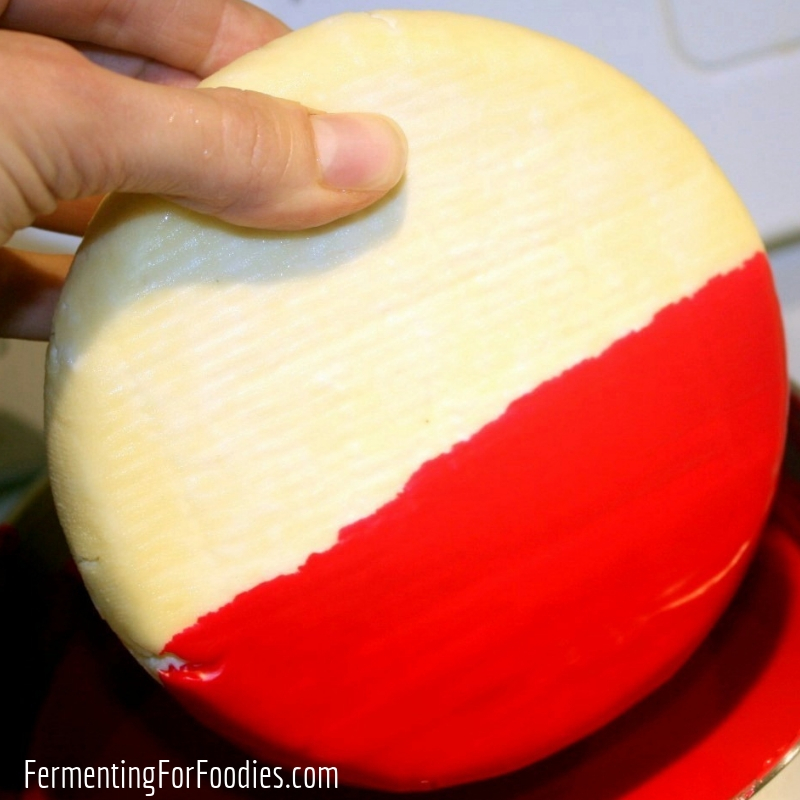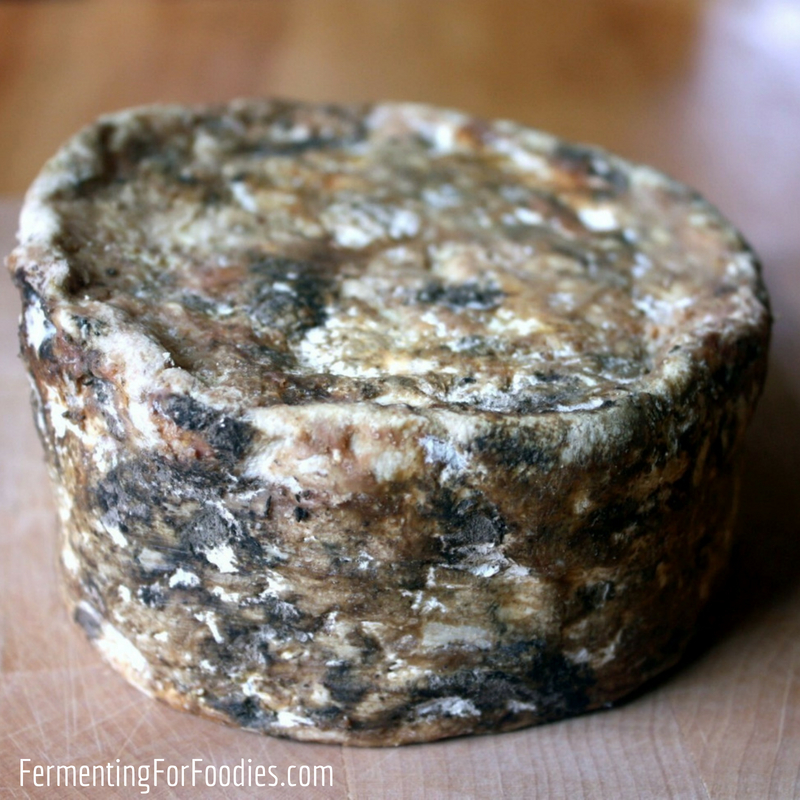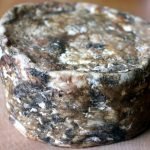Farmhouse cheese is a cooked curd cheese with a delicious cheddar-like flavor. It is a simpler hard cheese recipe that is made without a cheese press or cave.

It is a simplified recipe that I designed to work in my urban townhouse. And I don’t own a cheese press, a cave, or even a basement or garage to age cheese in!
Notes For Beginners
This recipe assumes some basic cheesemaking knowledge. For anyone new to cheesemaking, I recommend starting with making fresh cheese.
However, this is a good recipe for anyone interested in learning how to make hard cheese!
If you are uncertain about any of the steps, check out this post on how to make cheese for more detailed information on ingredients, equipment, and techniques.
Aging Farmhouse Cheese
Farmhouse cheese is perfect for experimenting with all the different ways to ripen cheese. The flavor and texture of this cheese will dramatically change depending on how it is aged.
Here are the four different ways to finish homemade hard cheese:
- Fresh unripened farmhouse cheddar is like quark or cheese curds. Store the cheese in the fridge right after pressing for an unripened hard cheese. This is a great option if you don’t have a way to age the cheese.
- Waxed farmhouse cheese is similar to Gouda or Cheddar. Waxed cheeses need to be thoroughly air-dried before waxing.
- Washed rind cheeses are brined after pressing. Then they are regularly washed salt water to encourage orange mold to grow on the outside of the cheese. This mold gives the cheese a strong stinky cheese flavor.
- Bandage wrapping is the easiest way to age hard cheese. It involved coating the cheese in a layer of butter then wrapping it in cheesecloth. The cheesecloth layer will mold, flavoring the cheese without any of the added work involved with washed rind cheeses. The layer of mold comes off cleanly when the bandage is removed.
See Aging Hard Cheeses for more details on how to wax or bandage hard cheeses, along with information on how to make an aging cave in your home.

Farmhouse Hard Cheese
Farmhouse cheese is a basic hard cheese that doesn’t need any special equipment. See the notes to create your own cheese press and cheese cave with items already in your house! Experiment with waxing, bandage wrapping, or making a washed rind cheese.
- Prep Time: 30 minutes
- Cook Time: 1 hour 30 minutes
- Total Time: 2 hours
- Yield: 1–2 lbs cheese 1x
- Category: Cheese
- Method: Cheddaring
- Cuisine: British
- Diet: Vegetarian
Ingredients
- 1–gallon whole milk
- 1/2 packet of powdered mesophilic starter or 1/4 cup of cultured buttermilk
- 1/4 tsp of rennet mixed in 2 Tbsp filtered water
- 1/4 tsp of food-grade calcium chloride in 2 Tbsp filtered water (if using homogenized milk)
- 1 Tbsp salt (non-iodized)
Instructions
- This is not a beginner recipe. Please read up on how to make cheese for more details about any of the steps.
- Heat milk to 90F (32C).
- Stir in culture and maintain at 90F for 45 minutes.
- Stir in calcium chloride, then add the rennet, mixing thoroughly. (If you’re using tablet rennet, then follow the instructions on the package).
- Maintain at 90F for 45 min and do not stir.
- When the curds show a clean break, cut the curds into 1/2-inch cubes.
- Cook the curds by stirring the cut curds every 5 minutes for the next 1/2 hour, slowly raising the temperature to 100F (38C).
- Line a strainer with butter muslin and pour the curds into it. (Save the whey! See notes).
- Hang the curd in the butter muslin and allow to drain for 1 hour.
- After an hour, place the curds into a bowl. Break the curds into small pieces and mix in the salt.
- Pack the curds into a cheese mold lined with butter muslin. Press at 11 lbs for 10 minutes.
- Remove the cheese, re-wrap it and turn it over, press at 22 lbs for 10 minutes.
- Re-wrap the cheese again and turn over, press at 44 lbs for 12 hours.
- See the section above for 4 ways to finish the cheese. (Fresh, waxed, washed, or bandage-wrapped).
- Age farmhouse cheese at around 55 F (13 C) and 75% humidity for 1 to 4 months.
Notes
- Sanitation is key to making hard cheese. It’s the only way to ensure that the cheese is cultured with exactly the right strains of mesophilic bacteria.
- If you don’t have a cheese press, then make your own using heavy objects from around your house. The cheese won’t be as firm if it isn’t pressed at 44lbs, but you will still get a semi-hard slicing cheese pressing with 11 lbs for the full 12 hours. Just flip twice, as directed, to evenly press the cheese.
- Don’t throw out your whey! The sweet whey from cultured cheese can be used to make ricotta. Here are a few other ways to use up whey.

I made parmesan that is hard as a rock with a cobbled together press in my basement. We should chat.
I actually have started wondering if the issue was around the milk I use. What milk do you use? Any interest in writing a guest post on Parmesan? 🙂 I started a hard Italian cheese, but I really couldn’t age any of my cheeses for more than a month, I just don’t have the space to devote to a cold room. I just used it for my photos on washed rind cheese, then used it up with pasta!
I made this cheese, after the second day of drying it looks excellent. Unfortunately, the cloth stuck to the cheese when pressing, maybe the cloth was not thick enough? I don’t have the wax at the moment so I’ll try to brine wash it, hopefully that will work?
I forgot to say, the first time I didn’t have the patience to let it ripen, I ate it, it was a little sour, but good enough to eat it urgently, all the family. 🙂
Great! Thanks for sharing! Sticking cheesecloth might be because it wasn’t finely woven. I recommend butter muslin if you can find it. Cheers!
This tastes great! I love cheese, to be able to make my own is the dream.
Glad you liked it!
Making this today! How long do you leave in fridge before slicing and eating? I’m not able to make a rind yet.
Honestly, food doesn’t last long in our fridge, so I usually start eating it right away! It will taste like cheese curds rather than an aged cheddar. But aging in the fridge won’t greatly impact the flavor. Enjoy!